Fall 2020 & Annual Report
Message from the Chair
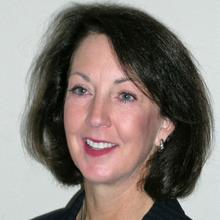
It is my honor to reach out to you as Chair of the Forensic Science Standards Board (FSSB) for this year. I have the pleasure of representing the Society of Forensic Toxicologists (SOFT) on the FSSB. I was fortunate to get in on the ground floor of OSAC in 2014 and am now starting the last year of my second term as an OSAC member on the FSSB. I continue to be extremely proud to be part of this effort! All OSAC members and affiliates give — and then give more — of their expertise and time to strengthen the use of forensic science in the United States.
The strides that have been made in communication since 2014 are the most impressive to me. The standard development process is not for the faint of heart! Building consensus is a lengthy, arduous process. Collegial conversations between members from different disciplines have occurred for decades, but now we see not only willingness, but proactive outreach between OSAC units and members with varying experience, expertise, and perspective. OSAC members continue to demonstrate that they are willing to listen to others and to learn from others. I have heard many OSAC members speak positively about the value of public comments and how those comments helped them to identify gaps or unclear aspects of draft documents. This reflects the fact that all involved are doing this work for the right reason.
OSAC members and affiliates continue to show their flexibility! We have all learned to do business differently these days. We have mastered the virtual meeting and continue to keep productivity at an impressive level. It is more difficult to build relationships in a virtual environment, but I see individuals making an increased effort to do so.
As of October 1, 2020, OSAC has officially transitioned its new structure and processes, but many standards had already been submitted to a standards developing organization (SDO) at that time. Those standards will continue to completion using the legacy process for Registry approval. Some flexibility will be required as Scientific Area Committees (SACs) and subcommittees manage documents in both the new and legacy Registry approval processes for a significant time.
I must recognize the incredible work done by the NIST OSAC Program Office (OPO) staff to bring OSAC’s new structure and processes to reality. Redesigning and revising a management system is a herculean effort that they have handled professionally and by deadline. I know that they have the gratitude of not only all FSSB members, but all involved with OSAC.
I look forward to working with all members of the FSSB over the next year to provide a strong foundation for the SACs and subcommittees to work efficiently and effectively during this period of transition. Increased time and energy will be focused on implementation of the standards on the OSAC Registry. Implementation of OSAC’s hard work takes action by all individual OSAC members and affiliates, all OSAC units, and the larger forensic community. We hope you will all join in this “push” this year. If you have a suggestion, comment, or concern related to OSAC, please let your chair, OPO, or me know. By listening to everyone we will continue to improve as an organization.
Respectfully,
Laurel Farrell, FSSB Chair
NIST Launches an Updated Organization of Scientific Area Committees for Forensic Science
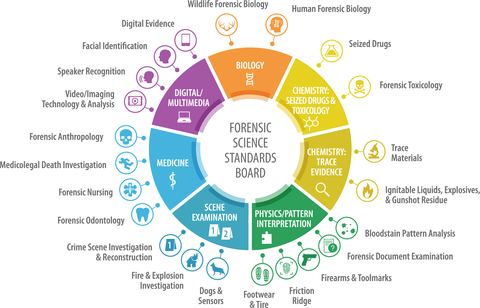
On October 1, 2020 NIST officially launched a new and streamlined OSAC. The changes to OSAC’s structure and processes will enable it to make high-quality, science-based standards available to forensic laboratories more quickly.
Changes to OSAC’s structure include expanding the number of SACs from five to seven, with the addition of a new SAC for forensic medicine and the separation of the chemistry SAC into two SACs. Also, closely related subcommittees have been combined to address topics that span multiple traditional forensic disciplines. These changes will improve internal coordination and reduce duplication of effort.
To address standards needs that span across SACs, the FSSB has the authority to create Interdisciplinary Committees (ICs). ICs can provide recommendations to the FSSB for specific topics or work on drafting standards. For example, the FSSB recently approved a Reporting and Testimony IC. The scope of this IC is to review current and draft OSAC standards and other published documents related to reporting and testimony and to provide recommendations to the FSSB on next steps. To avoid detracting from the efforts of subcommittees and SACs, additional OSAC members may be appointed to serve on an IC for as long as the scope of work allows. The FSSB will approve all ICs, their scope of work, and expected deliverables and assign FSSB liaisons.
In addition, the composition of the FSSB has changed. The Association of Forensic Quality Assurance Managers (AFQAM) is now represented on the FSSB, together with the American Academy of Forensic Sciences (AAFS), American Society of Crime Laboratory Directors (ASCLD), Association of Firearm and Tool Mark Examiners (AFTE), International Association for Identification (IAI), National Association of Medical Examiners (NAME), and Society of Forensic Toxicologists (SOFT).
Along with these structural changes, OSAC’s Registry approval process has also changed. Now, scientific and technical review panels (STRPs) will review proposed standards before they are sent to an SDO. Public comment will also be invited at an earlier stage. This will help ensure that proposed standards already meet OSAC’s high bar for quality before being forwarded to an SDO.
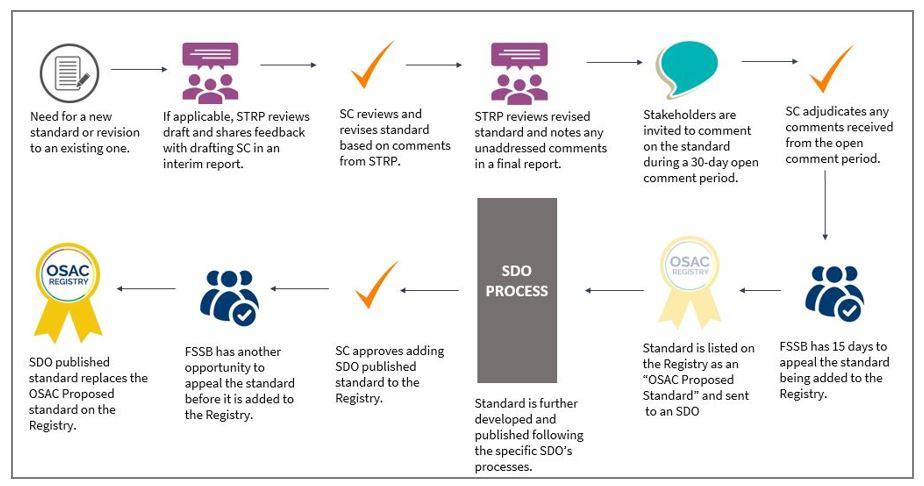
Furthermore, OSAC proposed standards will now be included on the OSAC Registry alongside approved published standards. This indicates that the proposed standards have undergone a rigorous quality review and can help fill the standards gap during the time it takes for an SDO to complete the standards development process. This will also allow laboratories to get a head start on implementing high-quality standards.
More details about the changes being implemented are available on the OSAC website.
If you'd like to contribute to OSAC by participating in an STRP or interdisciplinary committee, complete the OSAC application form.
OSAC Registry Updates: FY 2020 Q4
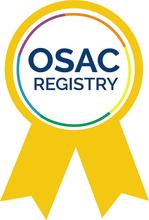
The OSAC Forensic Science Standards Board (FSSB) approved the addition of the following seven standards for listing on the OSAC Registry in FY 2020 Q4:
- ANSI/ASB Standard 022, Standard for Forensic DNA Analysis Training Programs, First Edition, 2019 (effective September 1, 2020).
- ASTM E2916-19e1 Standard Terminology for Digital and Multimedia Evidence Examination (effective July 7, 2020).
- ASTM E3017-19 Standard Practice for Examining Magnetic Card Readers (effective July 7, 2020).
- ASTM E3150-18 Standard Guide for Forensic Audio Lab Setup and Maintenance (effective July 7, 2020).
- ASTM E1967 Standard Test Method for the Automated Determination of Refractive Index of Glass Samples Using the Oil Immersion Method and a Phase Contrast Microscope (effective July 7, 2020).
- ASTM E2330 Standard Test Method for Determination of Concentrations of Elements in Glass Samples Using Inductively Coupled Plasma Mass Spectrometry (ICP-MS) for Forensic Comparisons (effective July 7, 2020).
- ANSI/ASB Standard 036, Standard Practices for Method Validation in Forensic Toxicology, First Edition, 2019 (effective July 7, 2020).
To access these standards and see a complete list of the Registry standards, please visit the OSAC website.
OSAC: A Year in Review
In addition to delivering quarterly updates, the fall edition of the OSAC Newsletter also serves as OSAC’s annual report and provides a review of OSAC’s accomplishments and activities over the past fiscal year, October 1, 2019 through September 30, 2020.
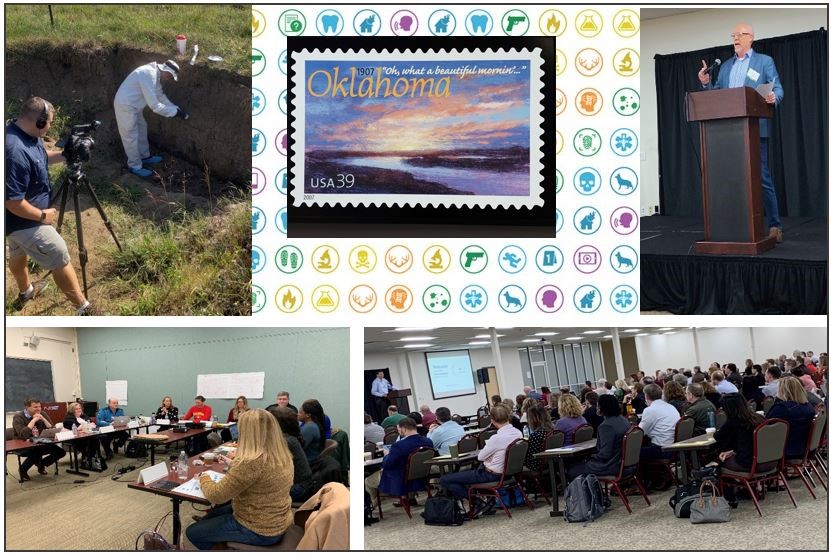
Organizational Snapshot
In February 2020, OSAC entered its sixth year of existence and currently has:
- 469 members
- 316 affiliates
- 2,700-plus member and affiliate applications received
As of October 2020, the employer and job classification of OSAC members include:
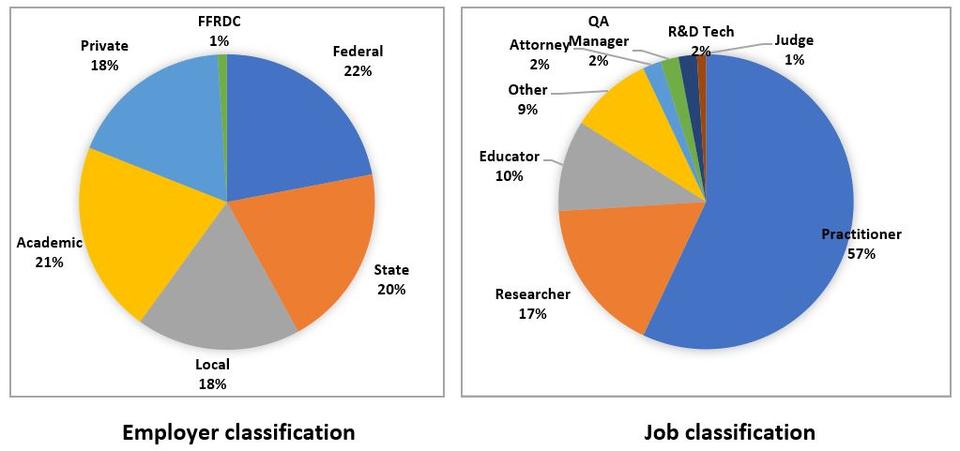
OSAC Registry

The OSAC Registry is a repository of high-quality, technically sound published and proposed standards for forensic science. These written documents define minimum requirements, best practices, standard protocols and other guidance to ensure that the results of forensic analysis are valid, reliable and reproducible.
In January 2016, OSAC added the first standard to the Registry: ASTM E2329-14 Standard Practice for the Identification of Seized Drugs. By the end of FY 2016, two additional standards were approved for placement the Registry. As shown in the graph below, the number of OSAC Registry standards continues to grow each year.
At the end of FY 2020, there were 37 standards on the OSAC Registry representing 13 specific forensic science disciplines and various interdisciplinary topics. In November 2019, for example, OSAC added the first interdisciplinary training standard to the Registry. This standard, ASTM E2917-19a Standard Practice for Forensic Science Practitioner Training, Continuing Education, and Professional Development Programs, details the key knowledge skills and abilities that should be included in laboratory training programs for forensic science professionals.
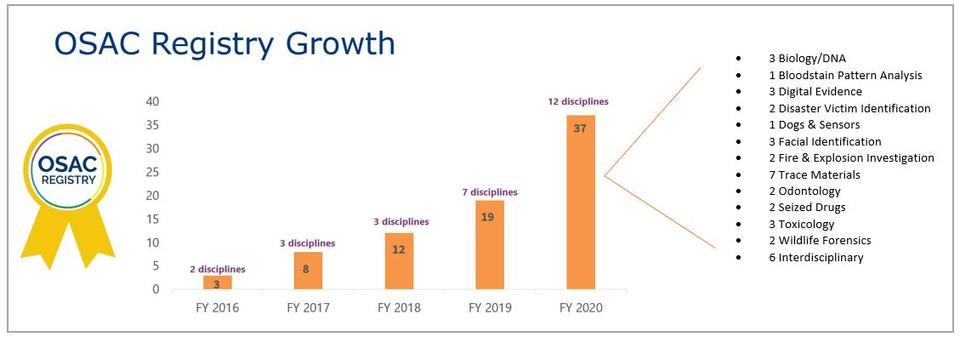
Looking forward, with OSAC’s new organizational structure and processes, both published standards and OSAC proposed standards will be available on the Registry, allowing laboratories to get a jump on implementing high-quality standards.
Visit the OSAC Registry webpage to see a current list of Registry standards and a breakdown of standards by fiscal year.
Registry Implementation Efforts
Standards are only useful if they are implemented. In 2018, the FSSB prepared the OSAC Registry Implementation Plan, which describes various strategies OSAC might use to encourage our stakeholders to implement the standards on the OSAC Registry.
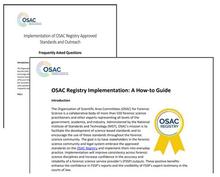
This past year OSAC focused its initial implementation efforts on crime laboratories and other forensic science service providers (FSSPs). To support these stakeholders with their implementation efforts, OSAC developed several resources:
- FAQs on Implementation of OSAC Registry Standards.
- OSAC Registry Implementation: A How-to Guide, which describes various pathways FSSPs can take to incorporate OSAC Registry standards into their management processes and documents, along with specific examples.
- The Registry Implementation Document Tracker provides a regularly updated list of all documents that are on the OSAC Registry and under development at OSAC and SDOs.
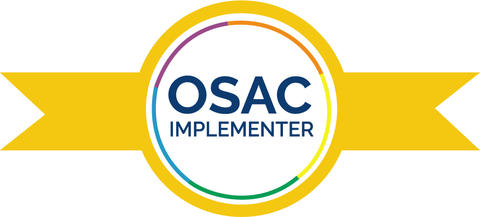
During FY 2020, five laboratories declared their commitment to implementing the standards on the OSAC Registry. The Georgia Bureau of Investigation – Division of Forensic Sciences made the decision to embark on the implementation journey in January 2017 and celebrated its three-year anniversary as the first forensic laboratory to implement the OSAC Registry standards. Another early implementer, the Houston Forensic Science Center (HFSC), has adopted guidelines recommended by OSAC in its continuous effort to improve forensic science results for Houston and impact the broader forensic science community. The Seized Drugs section of the Kentucky State Police Forensic Laboratories has committed to implementing all seized drugs-related OSAC Registry standards and has created a process to evaluate and consider incorporating new OSAC Registry standards each year. In addition, Bode Technology, the largest private forensic DNA testing laboratory in the U.S., has incorporated two of the DNA standards that are currently on the Registry. The Trace Evidence Analysis Facility (TEAF) at Florida International University is the latest organization to have officially declared their commitment to implementation and has adopted the standard for the analysis and comparison of glass evidence.

Additionally, last fall the Texas Forensic Science Commission recommended that all crime laboratories accredited to perform forensic analysis in the state of Texas voluntarily adopt the standards listed on the OSAC Registry. This recommendation impacts the 40 laboratories in Texas and another 40 out-of-state laboratories that perform services for the state.
Laboratories face many challenges when implementing standards. To better understand these challenges and identify solutions, OSAC worked with ASCLD’s Forensic Research Committee and Standards & Accreditation Initiatives Committee on their online survey to better understand these challenges and identify solutions. This survey, which was open from February through June 2020, captured baseline information about the implementation of OSAC Registry standards. ASCLD recently published the survey results in a white paper. OSAC will build on this work by continuing discussions with quality managers and laboratory directors about their implementation discussions and efforts.
OSAC Registry implementation efforts this year focused on forensic science service providers. Moving forward, we will expand our focus to include professional forensic science organizations, prosecutors, defense attorneys, and the courts. We encourage forensic science service providers to initiate the standards implementation process in their operations proactively, so they will be prepared to share the value of standardization when addressing these topics in court.
Ongoing Standards Activities
At the end of FY2020 there were more than three dozen standards on the OSAC Registry. In addition, there were:
- More than 100 SDO-published standards eligible for OSAC review for placement on the OSAC Registry.
- Almost 130 OSAC-drafted standards progressing through the development process at SDOs.
- More than 160 documents being drafted within OSAC.
Here is a snapshot of the number of documents each subcommittee had at each stage in the OSAC development process* at the end of FY20:
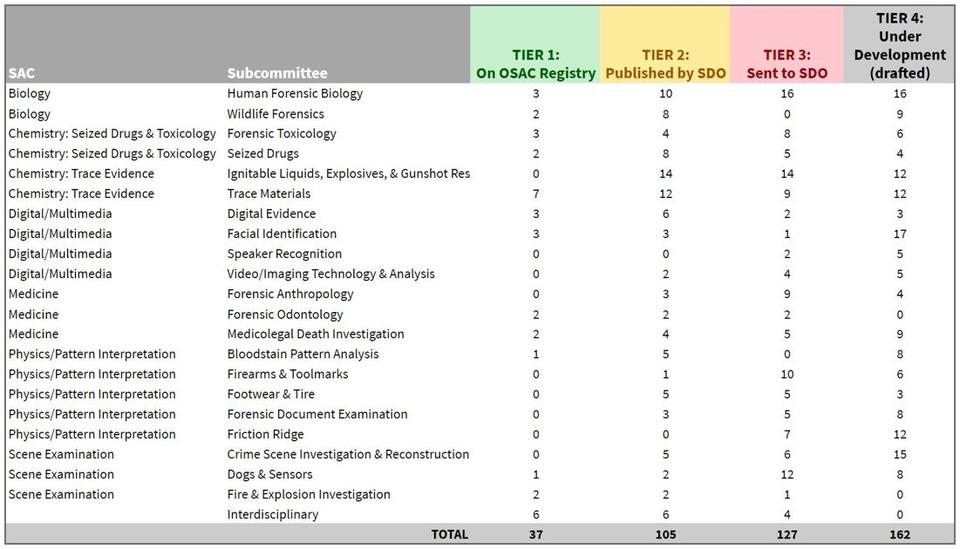
*Key:
Tier 1: Document on the OSAC Registry; approved by OSAC with highest level of vetting
Tier 2: OSAC supported document published by an SDO; completed the SDO consensus process
Tier 3: OSAC drafted document sent to an SDO for further development; drafted with input from OSAC’s Resource Task Groups and approved by SAC
Tier 4: Working draft document inside OSAC development process and not yet publicly available
The graph below illustrates the number of documents at OSAC's various tier levels for FY 2019 and FY 2020.
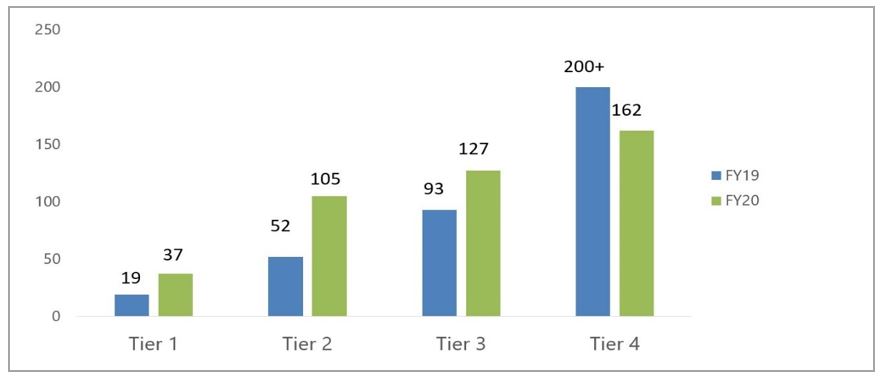
Accomplishments
In addition to growing the Registry and facilitating standards activities, products and accomplishments from the last year include:
- We have supported the development and publication of process maps for the bloodstain pattern, speaker recognition, and friction ridge disciplines. We have also supported the development of process maps for the DNA and firearms and toolmarks disciplines, which are expected to be published soon. Process maps are a useful tool that can help forensic science disciplines provide insight into their specific activities, identify areas for improvement and discover where standards may be needed.
- OSAC’s former Geological Materials Subcommittee, in collaboration with the University of Kentucky, the Federal Bureau of Investigation, and the IUGS-Initiative on Forensic Geology, developed a Collection of Forensic Soil Evidence Training Video to help educate law enforcement and crime scene professionals on how to collect soil and other geological evidence. This video is intended to accompany the draft collection guide, Standard Guide for Collection of Soils and Other Geological Evidence for Criminal Forensic Applications, developed by the former Geological Materials Subcommittee.
- We have updated OSAC’s Organizational Priorities and Minimum Topic Requirements for Standards Development document to better identify and clarify the minimum topic requirements that subcommittees should address when drafting forensic science standards.
- We have further developed the OSAC Lexicon. Since it was launched in March 2018, OSAC members have been hard at work improving this database of almost 4,000 terms. An immediate priority has been to obtain consensus on “OSAC-preferred terms”. This summer, the FSSB approved the addition of two new OSAC-preferred terms to the Lexicon: administrative review and chain of custody. There are now 20 OSAC-preferred terms that OSAC members are encouraged to use when drafting standards. The FSSB has also established an FSSB Terminology Task Group to review and consider revisions to the current process for obtaining consensus and approving OSAC-preferred terms. The Terminology Task Group will also manage the process for updating and maintaining the OSAC Lexicon.
- We have modified the OSAC application process. Now, applications will be kept on file for three years only. After that, all participants must reapply. In addition, we have revised the OSAC application form to improve ease of use and limit the amount of personally identifiable information submitted online. The new application will allow for interested parties to indicate areas of expertise and preference for serving on subcommittees, STRPs, and Interdisciplinary Committees.
- Members of OSAC’s Human Factors Task Group published an OSAC Technical Series Publication that provides guidance on designing, conducting, and reporting research on the validity of methods and examiner performance. This publication, Human Factors in Validation and Performance Testing of Forensic Science, brings together key points from the scientific literature on assessing human performance.
- Members of OSAC’s former Materials (Trace) Subcommittee conducted an interlaboratory study this summer to evaluate the draft of its Standard Practice for Interpretation and Report Writing in Forensic Comparison of Trace Materials. The first round of the study focused on paint analysis and members of the subcommittee are currently analyzing the data they received from 88 participant responses from a combined 1,320 scenarios. Results of the study will be available soon.
- Members of OSAC’s Human Forensic Biology Subcommittee, along with the AAFS Standards Board (ASB) and Promega, developed a three-part webinar series that provided information on new/emerging standards and best practices for forensic biology and DNA testing laboratories.
- The FSSB Technical Issues Task Group is collaborating with NIST research scientists to create a “challenge prize” for the development of a confirmatory algorithm that compares the analysis of paint samples for source identification with the analysis of Fourier Transform Infrared Spectroscopy (FTIR) spectra by a forensic examiner. This year, the project was scoped and spectral analysis was performed on paint samples collected from junk yard automobiles. This work will provide the “ground truth” samples needed for the challenge. The task group is now determining the sample sets that will be provided as “training” data for the algorithms and the criteria for judging. We hope to announce the NIST Challenge Prize before the end of this year.
- OSAC SACs and subcommittees have identified 137 research & development needs, with at least seven currently being funded.
- We improved our internal operations to increase collaboration among OSAC units and manage our documents more effectively.
- We continued to grow our digital presence, as evidenced by an increase in website views, downloads, and LinkedIn posts and followers. As our outreach grows, so does our ability to reach more stakeholders and educate the forensic science community about new standards being developed and championed by OSAC.
2020 OLSS Meeting Highlights
On September 1, members of the FSSB and SAC and subcommittee chairs participated in a virtual OSAC Leadership Strategy Session (OLSS). During this meeting, each of the chairs presented updates on their committee’s accomplishments, priorities, highlights, and non-standards activities that are planned for the coming year.
Each SAC will be reviewing and discussing their subcommittee’s activities to develop a prioritized list of standards and other work products to focus on this year. These priorities will be discussed at the upcoming FSSB meeting in December.
The following individuals were recognized at the OLSS meeting for their leadership and efforts to further the OSAC mission and objectives:
- Jose Almirall for his service as a member of the FSSB and chair of the Chemistry/Instrumental Analysis SAC.
- Craig Beyler for his service as chair of the Fire & Explosion Investigation SC.
- Andrew Bowen for his service as chair of the Geological Materials SC.
- JoAnn Buscaglia for her service as a member of the FSSB.
- Elissia Conlon for her service as the chair of the Disaster Victim Identification SC.
- Kenneth Furton for his service as the chair of the Dogs & Sensors SC.
- Thomas Holland for his service as the chair of the Anthropology SC.
- Steven Johnson for his service as chair of the FSSB and IAI representative on the FSSB.
- Kristine Kadash for her service as the chair of the Biological Methods SC.
- Melissa Kennedy for her service as the chair of the Toxicology SC.
- Sarah Kerrigan for her service as a member of the FSSB and FSSB Executive Secretary.
- Michael Kessler for his service as the chair of the Crime Scene Investigation SC.
- Keith Pinckard for his service as the chair of the Medicolegal Death Investigation SC.
- Todd Weller for his service as the chair of the Firearms & Toolmarks SC.
- Thomas (Rusty) White for his service as the chair of the Gunshot Residue SC.
The FSSB and OSAC Program Office would like to thank all OSAC volunteers for their time and effort and all the federal, state, and local government agencies, academic institutions, and criminal justice and forensic science organizations that support the OSAC mission by allowing their staff to participate.
New FSSB Appointments
The FSSB serves as the OSAC governing board and supports the organization by:
- Facilitating the promulgation of standards that will support the development of quality benchmarks and enhance consistency across the forensic science industry.
- Discussing and addressing issues related to the OSAC standards development process.
- Coordinating the activities of the SACs, subcommittees and interdisciplinary committees.
This October the FSSB elected a new Executive Task Group and welcomed five new members.
OSAC FSSB Elected Executive Task Group Members:

ANSI National Accreditation Board and SOFT representative
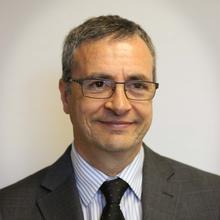
New York State Police Crime Laboratory System and ASCLD representative
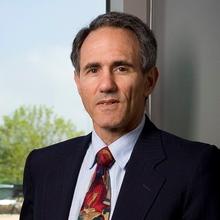
The Pennsylvania State University and Chair of OSAC's Legal Task Group
New FSSB Members:
- Craig Beyler, Jensen Hughes, Chair of Scene Examination SAC.
- Stephen Greene, U.S. Customs and Border Protection Laboratories and Scientific Services Directorate, IAI representative.
- Christopher Krug, Johnson County Sheriff's Office Criminalistics Laboratory, AFQAM representative.
- Marc LeBeau, Federal Bureau of Investigation (FBI), Chair of Chemistry: Seized Drugs & Toxicology SAC.
- Chris Taylor, Defense Forensic Science Center (including USACIL), Chair of Chemistry: Trace Evidence SAC.
Engagement Activities
OSAC is committed to sharing information about standards and activities that will impact the forensic science community.
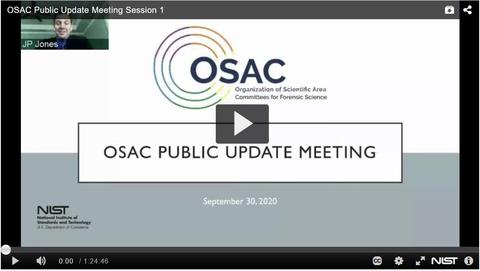
Each year, OSAC reports its activities in an open and online public forum and provides an opportunity for the public to ask questions and provide feedback. On September 30, 520 viewers tuned in to this year’s Public Update Meeting to hear presentations from the chairs of OSAC’s FSSB and five SACs. Each described the standards their unit is working on and discussed research gaps, challenges, and priorities for the coming year.
If you were unable to attend this year’s meeting, you can view the recording and presentations on the OSAC Events webpage.
In addition to the Public Update Meeting, OSAC was involved in over 50 other outreach and engagement events this fiscal year. Here are just a few examples:
- AFQAM Annual Training Session – October 2019
- Midwest Firearms Examiner Training Session – October 2019
- NY Crime Laboratory Advisory Committee Meeting – November 2019
- New England Division of the IAI – December 2019
- American Association for the Advancement of Science Annual Conference – February 2020
- AAFS Annual Meeting – February 2020
- National Association of Appellate Court Attorneys Meeting – July 2020
- Florida Association of Crime Laboratory Directors Annual Meeting – September 2020
- Chesapeake Bay Division of the IAI – September 2020
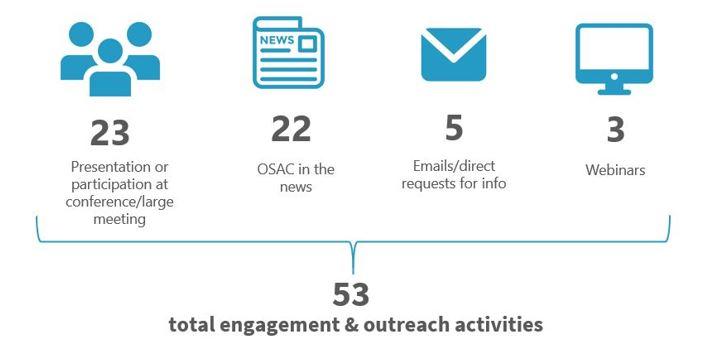
Final Words
OSAC has made great strides to help facilitate the development and implementation of technically sound and consensus-based forensic science standards. With almost 800 combined members and affiliates representing forensic science practitioners, laboratory managers, academic researchers, measurement scientists, and experts in statistics, human factors, legal, and quality infrastructure, we will continue to work together to strengthen forensic science through standards.
In Memoriam
Peter Tytell
Written by Gerry LaPorte, Chair of OSAC's Forensic Document Examination Subcommittee
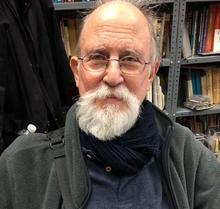
On August 10, 2020, our community lost a passionate, dedicated, and talented forensic document examiner and the world lost a genuinely warm-hearted, friendly, and affable man. Peter Tytell lost a long hard battle with cancer, but during his fight against this terrible and unrelenting disease, Peter always maintained a positive attitude and sense of humor. He continued to work relentlessly during his illness, especially when it came to working on OSAC standards as a member of the Forensic Document Examination subcommittee. Peter was internationally renowned and highly respected world-wide. He began his training in the early 1970s and he was always present at professional meetings, especially the Annual General Meeting for the American Society of Questioned Document Examiners (ASQDE), which he began attending in 1973 and missed only four times over the course of nearly 50 years. Peter was a consummate professional and never stopped wanting to learn.
In 2017, the ASQDE presented Peter with the Albert S. Osborn Award of Excellence, which was created to honor the Society’s most distinguished members. The criteria for this award is a perfect description of Peter - it shall only be bestowed on persons who have attained exceptional distinction in terms of cumulative activities, such as professional research or literary accomplishments which advance the field of questioned document examination, and outstanding service to the ASQDE over a long period of time.
For those who knew and interacted with Peter, we all have a common thread to our stories when we first met him. He was the first to welcome you to the field and always showed a sincere interest in your background. At the same time, he was modest about his own background, even though he was the world’s leading typewriter expert. Peter literally grew up surrounded by typewriters – he was 11 years old when he started working in his parents shop where they rented, repaired and restored typewriters.
Peter was an inspiration to forensic document examiners for five decades and his tenacity and dedication to strengthening our profession will always be remembered.
John Joseph ("Jack") Godfrey
Written by David Marks, Chair of OSAC's Speaker Recognition Subcommittee
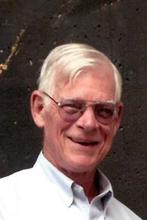
The human language technology (HLT) community has lost a giant. Ernest Hemingway said that, “Every man's life ends the same way. It is only the details of how he lived and how he died that distinguish one man from another.” Jack Godfrey’s obituary offers such details ranging from his birth in Queens, New York to his passing at the age of 78 in Broussard, Louisiana; from his Jesuit seminary training to his Ph.D. in Linguistics from Georgetown University; from his accomplishments as an avid fisherman to his talents as a woodworker; from his love of crossword puzzles to his passion for travel; and from his loving roles as husband, father, grandfather, brother, and uncle to his professional leadership in the HLT community. Jack’s life details are revealed in the full life that he lived and in the great many people whose life he touched along the way. But while these facts accurately represent aspects of Jacks’ life, they do not truly convey the full account of his energy, his drive to accomplish, and his commitment to include and inspire others to contribute with equal passion.
Those HLT colleagues who were fortune enough to work with Jack will appreciate the devotion with which he shaped the future of HLT throughout his career. Through his direction of the U.S. Department of Defense's HLT Group at the National Security Agency and his active role in OSAC (and its predecessor, SWG-Speaker), Jack demonstrated the energy and conviction to build a community enthusiastic about advancement of the technology. His enduring support of the NIST Speaker Recognition Evaluations propelled the entire HLT community toward continuous improvement. In professional interactions, Jack was the contemplative sage who had a way of challenging his colleagues in a gentlemanly way. During lively discussions, he would sit back and listen thoughtfully, and when he ultimately would offer his guidance, the dialog often subsided, as if his comments were the final authority on the subject. The high regard for Jack’s judgment was unmistakable.
In remembering his life, OSAC offers its heartfelt condolences to Jack’s wife, Nina, and the rest of his family, to his friends and esteemed colleagues, and to the members of the community they built together. Jack’s quick wit, the kindness and wisdom he shared with all who knew him, and his unwavering dedication to his profession will be sorely missed.
OSAC in the News

Implementing Blind Proficiency Testing in Forensic Laboratories: Motivation, Obstacles, and Recommendations
This Forensic Science International: Synergy article identifies some obstacles to implementing blind proficiency testing in forensic contexts and proposes ways to overcome them, including increasing engagement with OSAC in the standards development process.
NIST Launches an Updated Organization of Scientific Area Committees for Forensic Science
Read about OSAC’s structural and process changes that will enable it to make high-quality, science-based standards available to forensic laboratories more quickly. This article was also shared in Evidence Technology Magazine, BiometricUpdate.com, FINDBiometrics, and the ISHI Blog.
AAFS Publishes New Probabilistic Genotyping Standard
Initially drafted by OSAC’s Biology/DNA Interpretation and Reporting Subcommittee, this Forensic Magazine article discusses the publication of ANSI/ASB Standard 018, Standard for Validation of Probabilistic Genotyping Systems, First Edition, 2020.
Upcoming OSAC/Major Events

DECEMBER 7-9, 2020:
- Virtual meetings for Chemistry: Seized Drugs & Toxicology SAC and subcommittees
- Virtual meetings for Chemistry: Trace Evidence SAC and subcommittees
FEBRUARY 14-19, 2021:
- 2021 AAFS Annual Scientific Meeting (virtual)
MAY 3-7, 2021:
- Meetings for Scene Examination SAC and subcommittees
- Meetings for Physics/Pattern Interpretation SAC and subcommittees
JUNE 7-11, 2021
- Meetings for Digital/Multimedia SAC and subcommittees
- Meetings for Medicine SAC and subcommittees
JUNE 28 – JULY 2, 2021
- Meetings for Biology SAC and subcommittees
- Meetings for Chemistry: Seized Drugs & Toxicology SAC and subcommittees
- Meetings for Chemistry: Trace Evidence SAC and subcommittees
NIST Activities
FORENSICS@NIST2020
On November 5 and 6, NIST scientists talked about how they are using advanced methods in metrology, computer science and statistics to strengthen forensic science. In case you missed it, the presentations from this virtual event will be available soon.
NIST to Help Labs Achieve Accurate THC, CBD Measurements
Learn about the programs our colleagues at NIST have developed to help labs accurately measure key chemical compounds in marijuana, hemp and other cannabis products.

